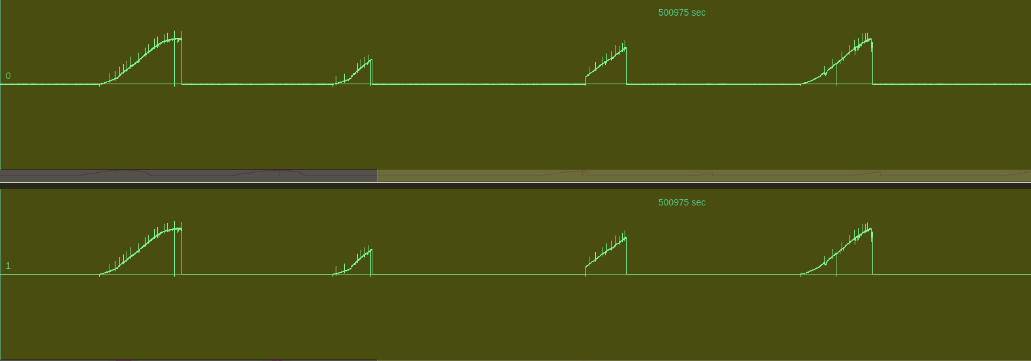We’re frequently asked whether Sense can tell the difference between two similar devices. For example, if a home has more than one fridge, TV, or light bulb — can Sense distinguish one from the other?
We’ve talked about how device detection is a bit like listening to a conversation where thirty people are speaking at once. Now imagine the challenge if some of those people had similar voices! A poorly designed energy-disaggregation algorithm might erroneously lump identical devices into a single, non-sensical one; and this will end up misleading the user. In this article, we shed some light on Sense’s approach to handling multiple similar devices in a home. From a technical standpoint, how does it work and what makes it challenging?
It turns out that even devices with the same make and model, in many cases, have properties that allow us to distinguish between them; in particular their timing patterns and electrical signatures. Of course, prior to distinguishing between two identical devices, the first challenge lies in determining the discriminating features of a particular appliance. In other words, before Sense can differentiate between two similar fridges, Sense first needs to distinguish between a fridge and other kinds of appliances such as dishwashers, toasters, vacuum cleaners, etc.
Timing patterns. Let’s say a user has two fridges that are absolutely identical: same year, make, and model. For fridges, we use wattage-based observations and cycling time as the distinguishing features. Even though the electrical signatures for the fridges are identical, it is highly unlikely that the two appliances will cycle synchronously (turn on and off at the exact same time). The mock example below illustrates an electrical signature with two fridges. Since Sense knows the cycling pattern of a typical fridge, by analyzing their on/off patterns, we discover that we are dealing with two separate fridges.
Light bulbs provide another example of how Sense uses device timing patterns to distinguish identical devices. A home might have a set of lights on a timer that go on at exactly the same time each day, as well as a group of similar lights which turn on randomly, as in the diagram below. Sense notices that there is a pattern, where a light switches on every day at 8 PM and switches off every day at 10 PM. This allows Sense to deduce that there are at least two lights here: a timed light and a light that switches on/off at random. That said, it is still quite difficult, if not impossible, to distinguish between identical light bulbs which are controlled by the same switch. Even Sense has its limits! In fact, light bulbs are proving to be quite challenging, particularly since they are the most commonly used, and most often identical, devices in a home. Sense usually identifies a few different light bulbs in each home, but also likely lumps a few together.
![]()
Electrical signatures. Sense also uses devices’ electrical signatures as clues to detect the presence of two identical devices. First, the physical properties of the components (eg. resistors, capacitors) that make up an appliance are different enough that Sense might distinguish between two devices of the same make and model. Second, the wiring in a particular room and the distance of the device from the monitor will affect the intensity of the electrical signatures that Sense records. For example, if we have two identical light bulbs in a home generating identical signatures, the bulb closer to the Sense monitor will produce a signal with a stronger amplitude than the one further away.
Network pings and integrations. What is Network Device Identification (NDI)? NDI allows Sense to listen to “pings” across the wireless network to look for clues that might help with Device Detection. With this feature enabled, Sense can listen to other smart devices in your home to see exactly when they turn on and off, even if you have multiple similar ones. For example: if you have Philips Hue lightbulbs installed in multiple rooms throughout your home, the Sense integration with Philips Hue can look at the names you’ve already set up inside the Hue app so you can monitor the Hue bulbs in your bedroom separately from the same bulbs in your kitchen, living room, or nursery. Or, if you have two identical devices in your home, you could also add smart plugs to each of them to immediately distinguish between them.
What can you do to help: renaming devices.
We know you really want to be able to help train devices! Read more about why that is tricky here. In the meantime, what you can do is rename your devices. When Sense identifies two similar device (say two fridges), they are displayed in the app as “Fridge 1” and “Fridge 2.” If you are interested in a more descriptive label, you can rename the devices in the app. So, for example, you may choose to change “Fridge 1” and “Fridge 2” to “Kitchen Fridge” and “Basement Fridge,” respectively.
You can also help Sense by renaming devices in your app more generally. For example, if you determine that “Unnamed heat 1” is in fact your “Keurig coffee maker,” just tap the bubble, then tap again, to rename it.
Although timing patterns and electrical signatures help Sense determine when more than one device is present, it is still no easy task. Just like trying to pick out one voice in a room full of similar voices — device detection is hard! As more homes have Sense monitors and enabled integrations, more training samples become available, and the Sense data science team is able to improve our algorithms and device detection capability. We realize you are eager for Sense to detect everything, and we promise you, we’re working on it! It’s a matter of time, data, patience, and persistence.
Please continue to rename those devices, and send us your feedback and suggestions. And in the meantime, we wish you happy sensing!
